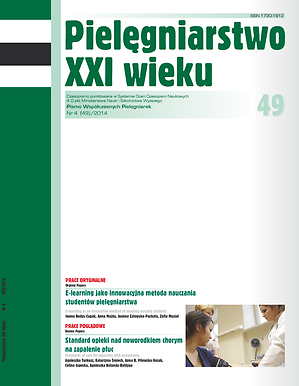Application of new technologies in echocardiography as a factor objectivizing test results
Keywords:
echocardiography, ultrasonography, cardiology, history of medicineAbstract
Application of new technologies in echocardiography as a factor objectivizing test results. At the turn of the twentieth and the twenty-first century new ultrasound techniques such as tissue Doppler echocardiography (TDE) and speckle tracking echocardiography (STE) were introduced to medicine and their development and application in clinical diagnosis are an example of medical staff being supported by new technologies. TDE and STE allow for the assessment of the left ventricular (LV) systolic function expressed in quantitative terms and the elimination of the influence of the echocardiographers’ subjective assessment. Knowledge on the possibilities of modern cardiological diagnostics is useful for nurses pursuing health education programs among people at risk of cardiac diseases.
References
1. Hensel KO, Jenke A, Leischik R. Speckle-Tracking and Tissue-Doppler Stress Echocardiography in Arterial Hypertension: A Sensitive Tool for Detection of Subclinical LV Impairment. Biomed Res Int. 2014;2014:472562. doi: 10.1155/2014/472562.
2. Riha O. Subjectivity and objectivity, semiotics and diagnosis. An approach to the medieval concept of illness. Sudhoffs Arch 1996; 80(2):129-49.
3. Sak J, Pawlikowski J. Medicine and thought-styles: on the 50th anniversary of the death of Ludwik Fleck (1896-1961). Isr Med Assoc J. 2012;14(4):214-8.
4. Perera T, Moseley J, Munro P. Subjectivity in interpretation of portal films. Int J Radiat Oncol Biol Phys. 1999;45(2):529-34.
5. Tomas I, Kotoromanović Z, Belaj N et al. Computer-aided evaluation of radiologist’s reproducibility and subjectivity in mammographic density assessment. Coll Antropol. 2013;37(4):1121-6.
6. Gosse P, Roudaut R, Dallocchio M. Is echocardiography an adequate method to evaluate left ventricular hypertrophy regression? Eur Heart J.1990;11 Suppl G:107-12.
7. Sühling M, Jansen C, Arigovindan M et al. Multiscale motion mapping: a novel computer vision technique for quantitative, objective echocardiographic motion measurement independent of Doppler: first clinical description and validation. Circulation. 2004;110(19):3093-9.
8. Szymczyk E, Lipiec P, Michalski B, Kasprzak JD. Technika śledzenia markerów akustycznych 2D i 3D: zastosowanie kliniczne Kardiol Pol. 2013;71(1):77-83.
9. Edler I, Lindstrom K. The history of echocardiography. Ultrasound Med Biol. 2004;30(12):1565-644.
10. Singh S, Goyal A. The Origin of Echocardiography. Tex Heart Inst J. 2007; 34(4): 431-8.
11. Acierno LJ, Worrell LT. Inge Edler: father of echocardiography. Clin Cardiol. 2002;25(4):197-9.
12. Sutherland GR, Stewart MJ, Groundstroem KW et al. Color Doppler myocardial imaging: a new technique for the assessment of myocardial function. J Am Soc Echocardiogr, 1994; 7(5): 441-58.
13. Łanocha M, Katarzyński S. Tkankowa echokardiografia dopplerowska. Kardiologia Oparta na Faktach 2010; 3: 287-94
14. Sanderson JE. Heart failure with a normal ejection fraction. Heart 2007; 93(2): 155-8.
15. Olszewski R. Zastosowanie techniki śledzenia markerów akustycznych w ocenie funkcji lewej komory serca. Badania in vivo i in vitro. IPPT Reports on Fundamental Technological Research 2012, 2: 5-161.
16. Helle-Valle T, Crosby J, Edvardsen T et al. New noninvasive method for assessment of left ventricular rotation: speckle tracking echocardiography. Circulation. 2005;112(20):3149-56.
Downloads
Published
Issue
Section
License
Copyright (c) 2014 Authors

This work is licensed under a Creative Commons Attribution 4.0 International License.




